Artist based in San Francisco, CA
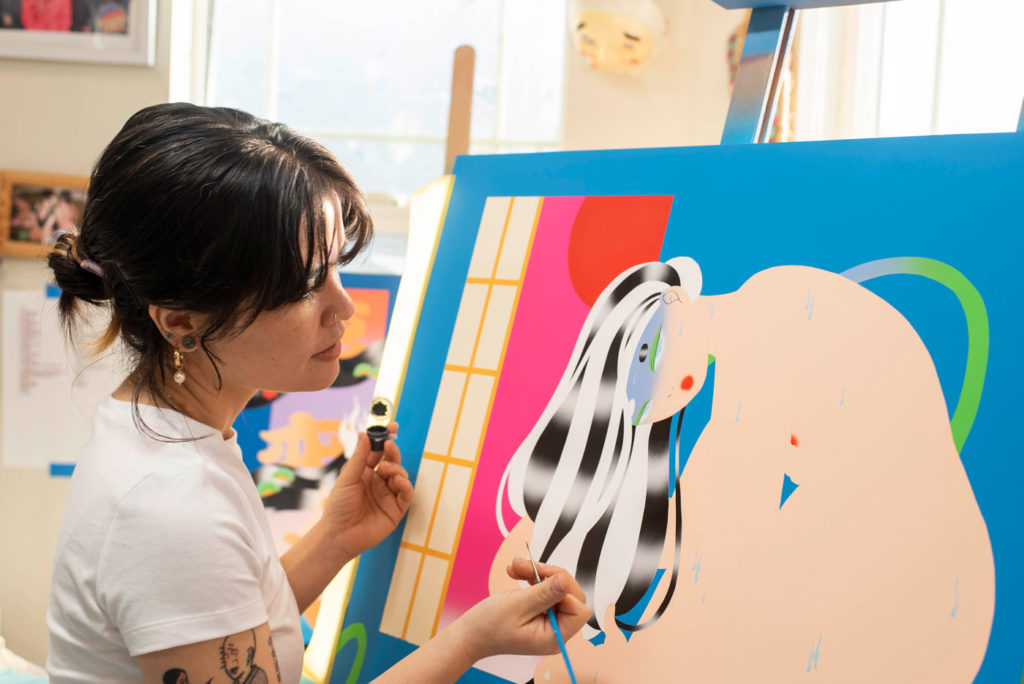
Maya Fuji, Portrait of the artist. Photo by Elliott Alexander
Tell us about yourself, what's your background?
I am a Japanese-American painter from both Kanazawa, Japan and the California Bay Area. My work is inspired by both my cultural heritage and the exploration of the liminal space I live in as an issei (first-generation) mixed-race woman in the United States. I’ve always been fascinated by traditional Japanese mythology and folklore, as well as Shōwa and Heisei–era subcultures. In my work, I expand on these themes within the context of my personal experiences. A recurring theme I often work with is the exploration of what forms our sense of identity, and how that can shift during our lifetime on account of generations living abroad. Imbuing the complexity of being multicultural, multinational, and multiracial is central to my works, as my paintings contrast the nostalgia of childhood memories with underlying feelings of being a foreigner simultaneously navigating Japanese and American communities. I try to illuminate self-discovery through narration and investigation of the otherness I have felt throughout my life, and use it as a catalyst to reconnect with and reclaim space within my heritage.
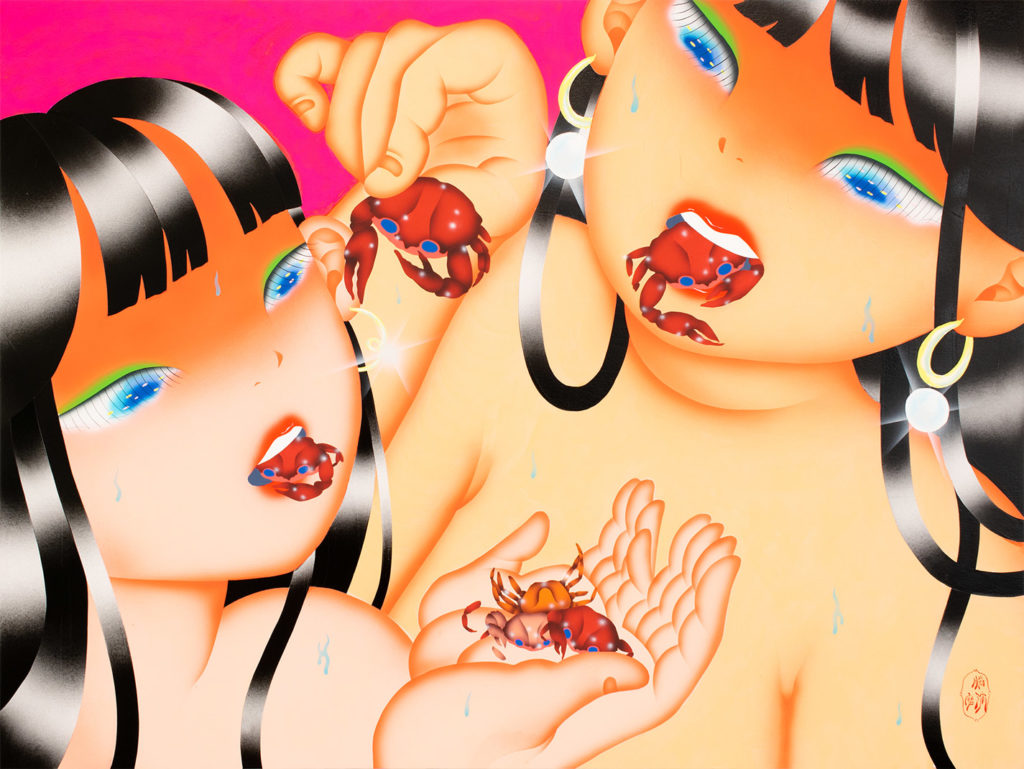
Eating Crabs At Country Station (Close Up), 2022, Acrylic on Wood Panel, 18 x 24 x 1.5 in
Having two artists as parents, painting and drawing were always a part of my life since childhood. My education, however, has nothing to do with art. I graduated with a Bachelors of Business Administration from SF State and was working on getting my Masters in Accounting at the University of Hawaii with the intent to become a tax accountant. In grad school, I began interning at an accounting firm and that's where I realized this career path was not going to make me happy. I had the most joy when working on my creative “hobbies” outside of work, and so I took a leap of faith and quit grad school to begin pursuing art more seriously. Because of this I am mostly self taught, and continue to experiment and grow my practice as I spend more time in my studio.

Playing In The Water With Ayame, 2022, Acrylic on Wood Panel, 30 x 40 x 1.5 in
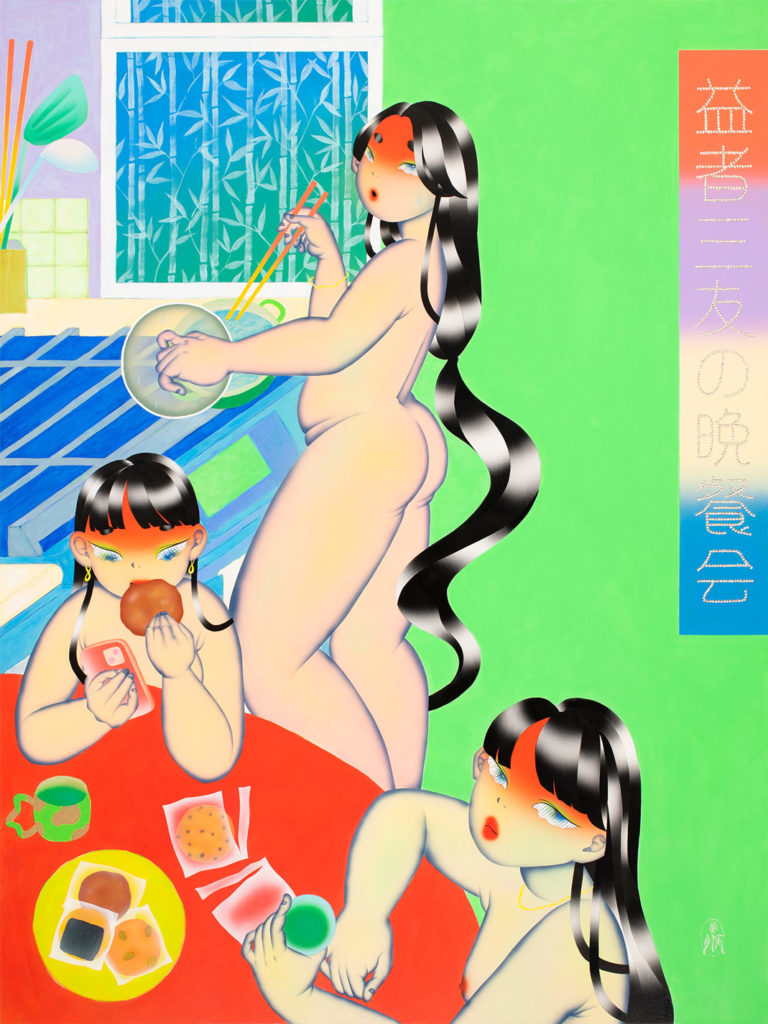
A Midnight Feast/益者三友の晩餐会, 2022, Acrylic & Rhine Stone on Wood Panel, 30 x 40 x 1.5 in
"Losing my grandmother felt like losing a primary connection to my Japanese identity. In this series of paintings, I’ve been recreating imagery of her home through fragments of my memory, often blending moments spanning over years. "

Braiding Hair With Morning Glories, 2022, Acrylic on Wood Panel, 36 x 36 x 1.5 in
What are you currently working on and where did the inspiration for it come from?
I am currently working on a collection in remembrance of my Japanese grandmother and what her legacy meant for my connection to my Japanese identity. She ran a small tobacco shop out of her house in Kanazawa and I have fond memories of visiting her home during summers as a child. Her shop was often a hub for people from the neighborhood and was a relic of old-school community gathering spots. I recently realized that although I have many photos of the neighborhood she lived in (her house is surrounded by tourist destinations), I barely have any photos of her home and tobacco shop, which was her pride and joy.
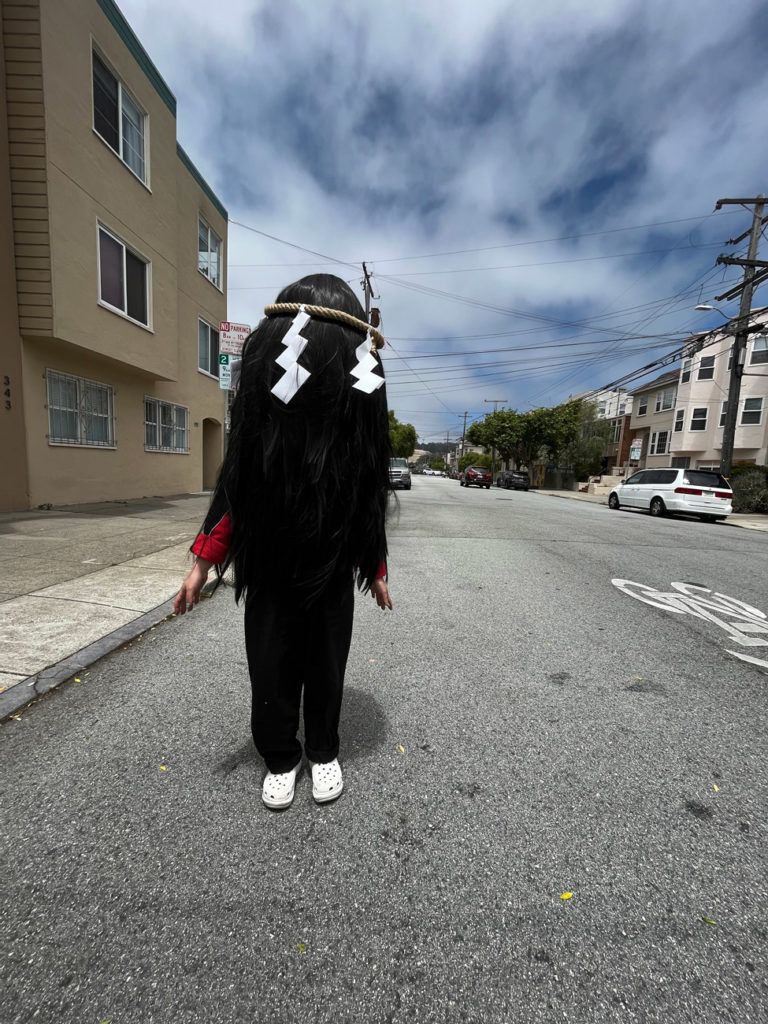
Me wearing one of my installations, yokai

Reference photo of grandmas tobacco shop
The house caught on fire a few years back and no longer exists, and when I realized it’s existence now only lives in my memory, it was as if I was reliving her loss all over again. The grief I felt is also connected to being an issei. Losing my grandmother felt like losing a primary connection to my Japanese identity. In this series of paintings, I’ve been recreating imagery of her home through fragments of my memory, often blending moments spanning over years. I’ve been talking a lot with my mother to recall nostalgic little details and have been sprinkling them throughout like easter eggs. I will be presenting this series in my upcoming solo exhibition in November at SWIM Gallery in San Francisco.
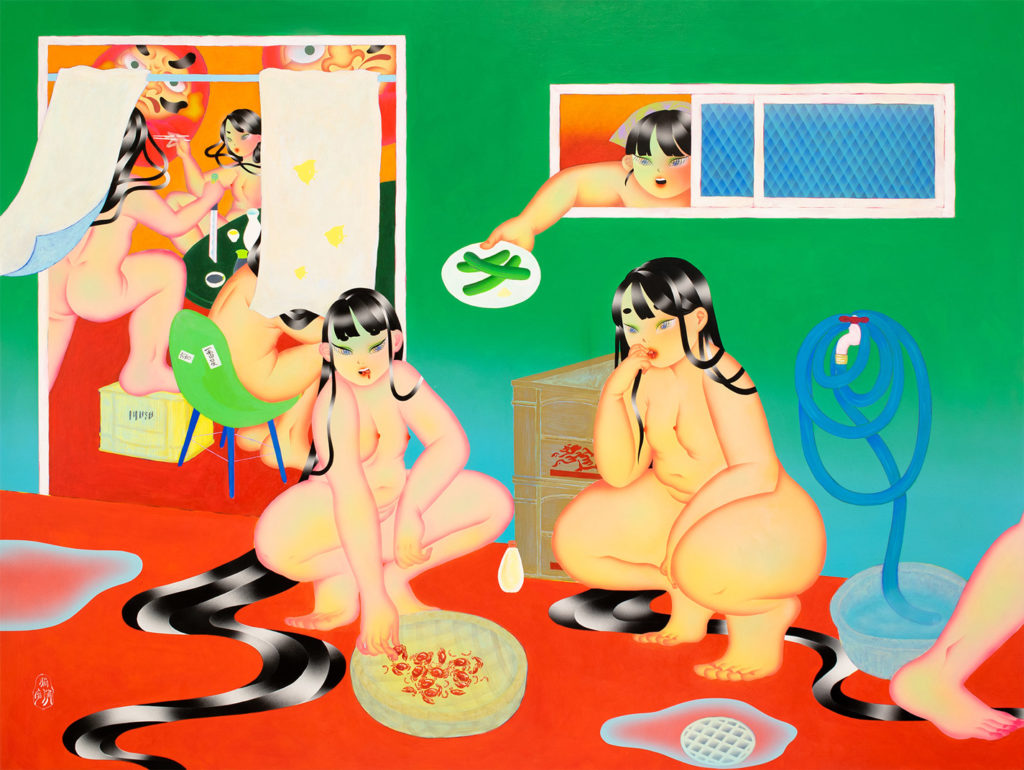
Eating Crabs At Country Station, 2022, Acrylic on Wood Panel, 40 x 30 x 1.5 in
Innovation does not only happen in the field of technology — it occurs everyday in a creative practice. What do you do for inspiration?
I find inspiration in reading about folklore and mythology and try to interpret their meanings through the context of modern day life. I often find myself asking how these lessons from hundreds of years ago can apply to our lives today.
I also find inspiration in connecting with others with a similar story to mine. As Asian-Americans, we often have a secondary experience of our culture, and layering a multiracial background to that can add even more complexity to reality and perception. I find sharing experiences about how we exist as multicultural people in the US and how we each individually preserve our culture is a healing and uplifting experience. I think these themes can resonate with people from all kinds of backgrounds, not just people with Japanese heritage. I love connecting and hearing stories of people’s experiences and how they stay connected to their multiple cultures.
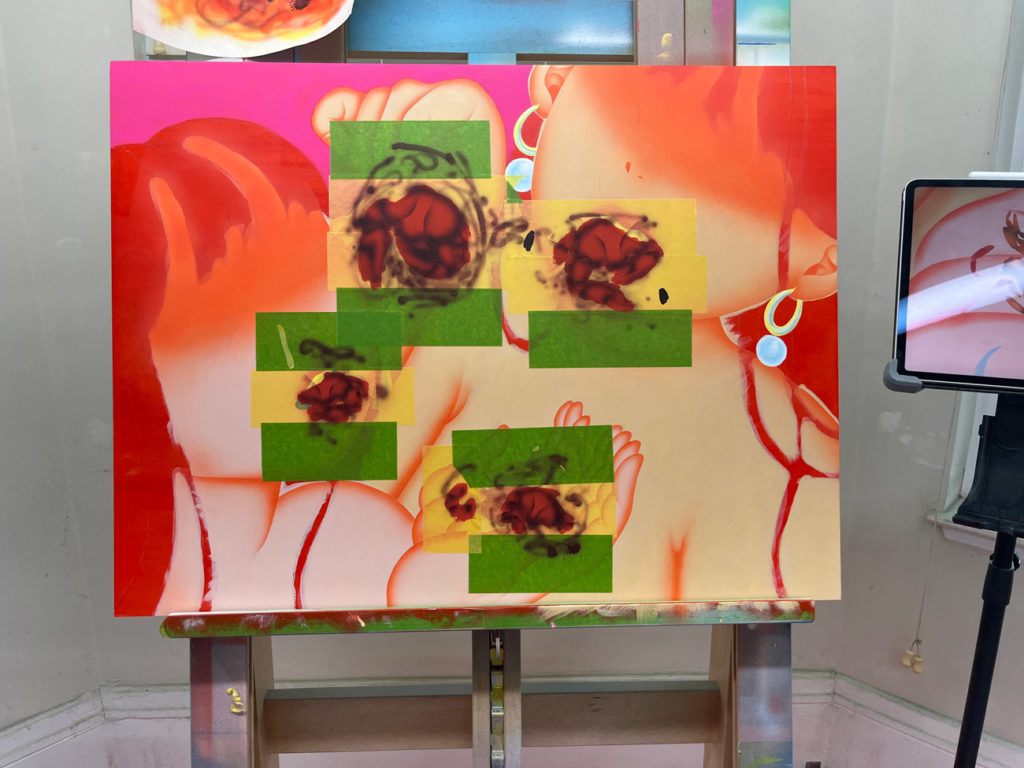
Process photo of taping off painting for airbrushing
Describe your practice and process. Where do ideas start for you? In the studio or being in the world?
Many of my ideas stem from something I read, some fascinations I’ve had, nostalgic memories, or stories shared with me. I then will often spend days/months thinking about how these are related to or tie into my work until it starts to form into something more substantial. I’ll sometimes jot down small phrases that, over time, come together as fully formed ideas or inspirations.

Studio view Photo by Elliott Alexander
How do you make your work, does it start with a sketch?
My work usually starts digitally. I use the iPad to sketch and map out the design, and then play with color until I have a plan for what I will be painting on the panel. The use of color is very important for me to convey a general mood, and I often draw from color combinations that were commonly used in more traditional artworks such as Ukiyoe prints, fusuma (sliding door) illustrations, and dentōshoku (traditional Japanese color palettes). I like to blend these with newer Shōwa and Heisei era palettes, as well as the vibrant colors found in lots of Japanese subcultures such as manga illustrations and truck/motorcycle gang’s blingy rides.

Process photo of taping off painting for airbrushingress
Do you have your own studio ritual? What does that look like for you?
I have a part time job at a restaurant, which gives me a lot of flexibility in studio hours. I am a huge night owl so I often paint through the night. I unfortunately am not a creature of habit or routine, and so often will paint for 12-18 hours straight, and then not paint for a couple days after that. While painting, I like to listen to audio books or podcasts, or watch shows on my iPad. I’ll switch between something serious or trash tv depending on my mood.

Reference photo of grandmas house
Who are your biggest influences?
These actually change pretty often, but right now I am inspired by artists such as Utagawa Kuniyoshi, Mizuki Shigeru, Saeki Toshio, Hosoe Eikoh, Takahashi Rumiko, and Ito Junji.

The Last Hairpin, 2022, Acrylic on Wood Panel, 18 x 24 x 1.5 in
Are there books or films that are an important source of inspiration?
Because I like to draw inspiration from mythology, history, subcultures, and traditional crafts, I have many history and reference books about these. I also like fictional films that play with these themes, like (I know, cliche) Spirited Away, and Princess Mononoke. Another less talked about Ghibli film called Only Yesterday is about living life the old way in an agricultural community in the Japanese countryside, which I found very touching. Yakuza, horror, and anime films such as Gokudo No Onnatachi Horetara Jigoku, Audition, House, and Perfect Blue might have had influences as well.
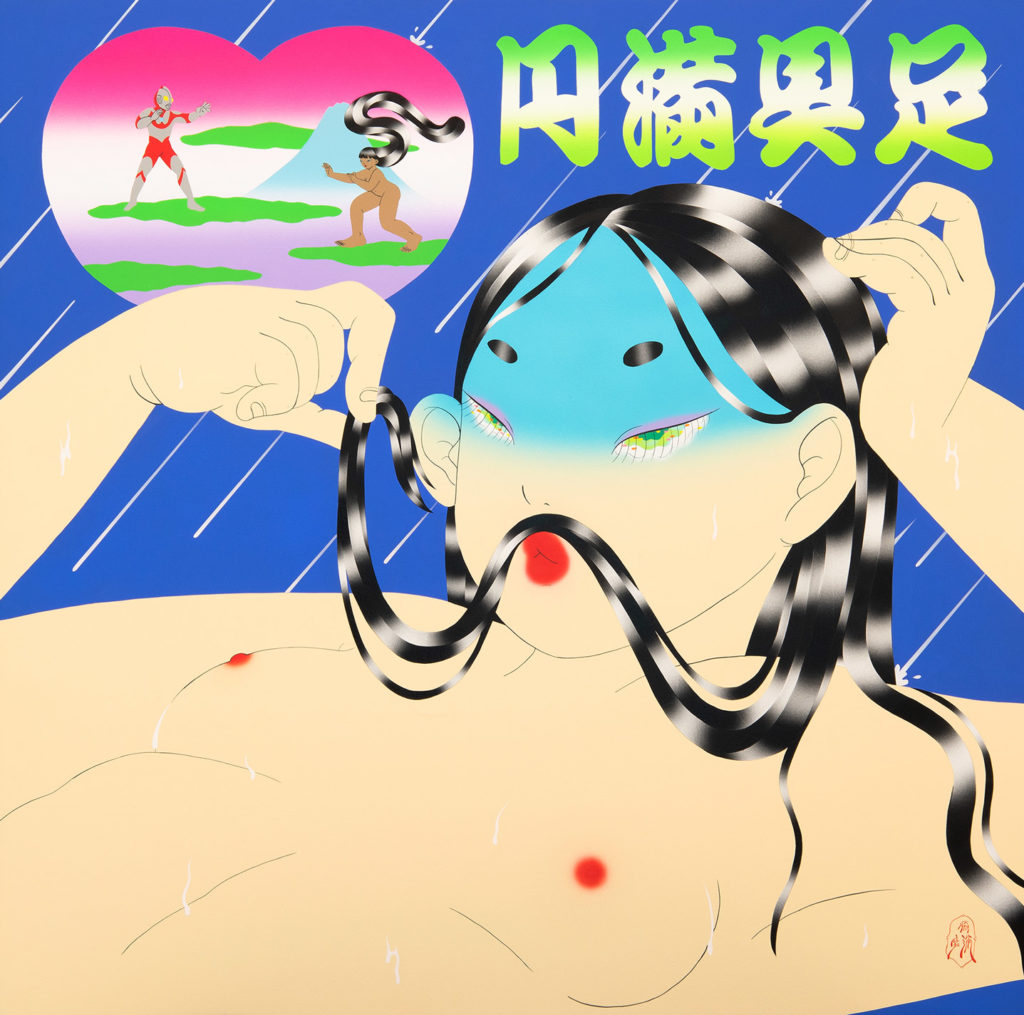
Perfectly Content/円満具足, 2022, Acrylic on Wood Panel, 24 x 24 x 1.5 in
What’s the best piece of advice you’ve been given?
Make art every day! I put this into action during lock down in 2020 and that is when I was able to really develop as an artist.
What is the best advice you would give to other artists?
This is sort of following up with the last questions and is also something I need to tell myself as well: practice makes perfect, but also don’t burn yourself out. Balance is very important!
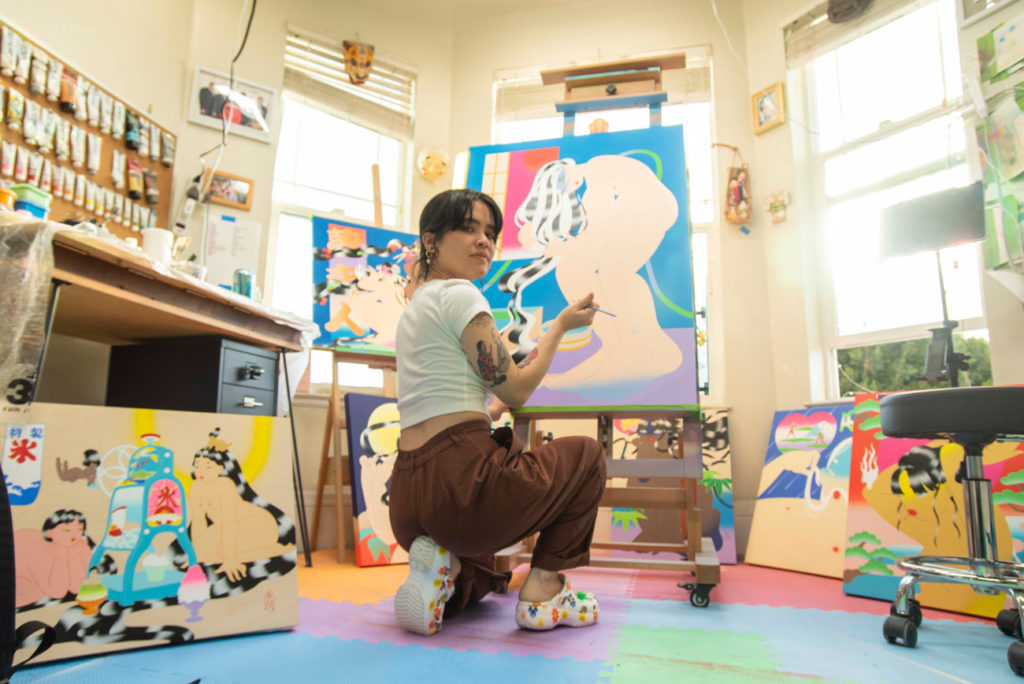
Photo by Elliott Alexander
Stay up to date with Maya Fuji
Instagram @fuji1kenobe
mayafuji.com